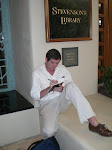I wrote this review of Star Wars Episode III: Revenge of the Sith after a midnite premiere screening at Abbey Cinemas in West Milford, NJ. This review won an NJSPJ award for best review writing in 2005.
"You will discover emotions you thought you had lost as a child," I was told by someone who had seen "Star Wars Episode III Revenge of the Sith" at a charity screening weeks before the premiere.
So it was with this inner child in tow that I went to Abbie Cinemas in West Milford to see a midnight screening of the final installment of a film series that has affected popular culture like no other film before it.
The members of the audience came from all walks of life. Yes, there were high school students, but there were also families-parents who grew up with the saga on the big screen, and their children who grew up with it on VHS. And there were the twentysomethings-we who collected toys and commerative glasses from fast food chains.
As with the premiere of Episode I, the audience cheered when the 20th Century Fox logo and Fanfare first appeared. They cheered when the Lucasfilm logo first appeared. And they cheered even louder with the first chords of the Star Wars Main Theme and the iconic opening crawl that stretches out into the infinity of the galaxy.
They reacted just as they would if they had been encountering an old friend. Which is exactly what the Star Wars universe is to the people of my generation. As I looked around the room, I realized that most of the people in attendence, however, were no older than high school seniors - probably not even alive when the last of the orignal trilogy movies (Return of the Jedi) was released in 1983.
Was their experience, then, any different from mine? After all, I had been with the saga from the very beginning. I was there with Luke when he received his "call to adventure." I was there when Han was frozen in carbonite. I was there when a band of primitive furballs helped take down the Empire.
In a way, seeing the final installment of this saga felt like the end of my own "hero's journey." Then again, according to Lucas mentor Joseph Campbell, aren't we all on that journey?
And that really is the point of the movies. Lucas set out to create what is known as "monomyth" - a tale that incorporates the archetypes of all the great myths of the world. The Star Wars saga was meant to stimulate the imaginations of everyone who experienced it,regardless of age, religion, or gender.
Throughout the entire saga, we have been introduced to archetypes whose incarnations span the whole of the world's cultures. From the samurai inspired Jedi order, to Luke Skywalker the reluctant hero, to Anakin Skywalker the tragic hero, the characters and events that make upthe Star Wars universe resonate within the audience because they are really part of what Carl Jung called "the collective unconscious" - the myth models that everyone is born with and exist in our subconscious minds.
It was this idea, which was further explored by scholar and writer Joseph Campbell, that Lucas adopted as the basis for his space opera. Much has been written about Lucas' cinematicinfluences - Kurosawa's samurai epics, the Flash Gordon serials, even The Wizard of Oz - but it was the idea of all the world mythologies having a common bond that spurredhis creative impulses.
Lucas drew much inspiration from Campbell's influential work "The Hero with a Thousand Faces," which explored the similarities between various cultures myths, and how they rely on narrative archetypes that propel the story and give it emotional weight.
The story of fallen Jedi Anakin Skywalker - the man who would be Vader - is the true narrative arc of the saga, and the prequel trilogy explores his descent into the Dark Side of the Force. His story is ripe with classical archetypes, namely the catalyst for his fall. InCampbell's "Hero" he speaks of the influence of the mother on the child's life. "Anyprolonged absence of the parent causes tension in the infant and consequent impulses of aggression," Campbell writes. In Episode II, we learn that Anakin's mother, a slave on Tatooine, had been abducted and murdered by Tusken Raiders. His slaughter of her killers in an act of revenge, sowed the seeds for his fall from grace.
By Episode III, Anakin is married to Padme, who informs him that she is pregnant. In prescient dreams, Anakin learns that she will die in childbirth. He also learns that Dark Side powers can grant a practitioner control over death itself. But death is a natural part of life, and as Campbell meditates we must say "yes" to death in order to say "yes" to life as well. Anakin's denial of a natural part of living is the impetous for his descent, and it is up to his children to redeem him.
After all, "Vader" is Dutch for father, and their existence reawakens the compassion of the parent that has been dormant for so long.
Throughout this final installment, Lucas makes connections to the fondly remembered original trilogy-when we first see Padme, she sports a hairdo reminiscent of Princess Leia's cinnamon roll haircut; even the beloved Millenium Falcon makes a brief appearance.
However, the real reason people flocked to see Episode III was to see the transformation of Anakin Skywalker into the iconic Darth Vader-and this "rebirth" carries the emotional weight of a grand opera. Even the final image is evocative of an iconic moment from the original trilogy.
Just as Episode III links the new trilogy to the original trilogy, fans who were there from the beginning will rediscover a link to the innocence and imagination of childhood.
Thursday, June 18, 2009
Subscribe to:
Post Comments (Atom)

No comments:
Post a Comment